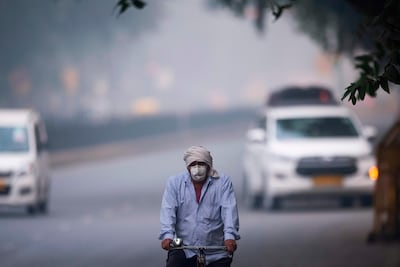Delhi is a "gas chamber". So said its chief minister Arvind Kejriwal as a thick, soupy smog blanketed India's second most populous city, closing schools and offices and leading officials to declare a public health emergency. Delhi has long battled with toxic pollution but it has reached such dangerous levels that when German Chancellor Angela Merkel was photographed with Indian Prime Minister Narendra Modi last weekend, the presidential palace was almost invisible behind them. Five million masks have been distributed to schoolchildren in the capital as air pollution hit the worst levels in the city in three years but more drastic measures are desperately needed to curb a health crisis that threatens to shorten life expectancy and lead to critical health conditions.
The dangerously high levels of particulate matter in the air have manifested in red eyes, itchy throats, respiratory problems and the pervasive smell of burning, making it difficult for Delhi's 20 million residents to breathe. The sale of nebulisers has soared and dozens of babies have been hospitalised, struggling to get fresh air in their lungs. Every winter, pollution gets worse as thousands of Diwali firecrackers are set off. The crackers were officially banned last year but the crackdown needs much stricter enforcement. They have added to the grey pall hanging over the city, but a key reason for the smog is the burning of crop stubble on farmlands in north Indian states that causes smoke to drift into neighbouring Delhi. Humidity and a lack of wind at this time of year cause the smog to stagnate and linger, making it impossible to spend time outdoors.
It is not normal for children to be unable to go to school or workers to stay away from offices because the air quality is deemed too hazardous, yet this is only likely to happen more frequently as pollution levels escalate and scant measures are taken to curtail them.
Face masks can only do so much and cannot filter out all harmful particles. Delhi introduced a temporary car rotation scheme on Monday, the third time it has done so, to limit traffic pollution. However, these steps fall woefully short of being effective.
A stronger approach is needed to deliver clean air. It is the responsibility of officials to ensure exposure to the potentially lethal cocktail of particulate matter, carbon dioxide, nitrogen dioxide and sulphur dioxide – 20 times the maximum recommended by the World Health Organisation – is limited. While breathable air should be a birthright for all, not everyone is equally affected. The livelihoods of millions of Delhi dwellers, from traffic police officers to rickshaw-pullers and vegetable vendors, depends on them being outdoors. It is impossible for them to heed a well-intentioned but ultimately redundant public advisory warning to wear a mask and stay indoors. Indeed, poor quality air does more harm to the underprivileged, who cannot afford expensive face masks, air purifiers or the air-conditioned cars available to the wealthy elite. Nor can they afford to simply leave the city, as some more privileged residents do, until the air clears.
Cities such as Beijing, Berlin, Bogota and Los Angeles have deployed tighter regulations for road users to constrict pollution, although the impact of these measures remains unquantifiable. In Mexico City and Bogota, however, where number plates were monitored in the same way as Delhi to restrict traffic, drivers simply gamed the system by buying second cars.
This year India launched its National Clean Air Programme, which aims to reduce particulate pollution by 20 to 30 per cent nationally, to be implemented over the next five years. These are important steps but the public health emergency requires equally urgent action. Delhi residents cannot afford to wait five years for projects to take effect.
The climate change crisis is a global concern and it behoves the international community to come up with solutions that will benefit nations struggling to resolve their challenges. Delhi too must seek guidance from nations that have adopted sustainable models that work. Beijing, for example, was once deemed to be the most polluted city in the world but after increasing its budget to tackle pollution $434 million in 2013 to $2.6 billion in 2016, levels of pollutants plummeted.
India must similarly treat this as a priority when it comes to allocating its budget. But this is not simply India’s problem; the air we breathe affects us all and smog hanging over India could have a catastrophic impact on the global climate. It must be tackled before becoming a crisis that impacts even more communities.


